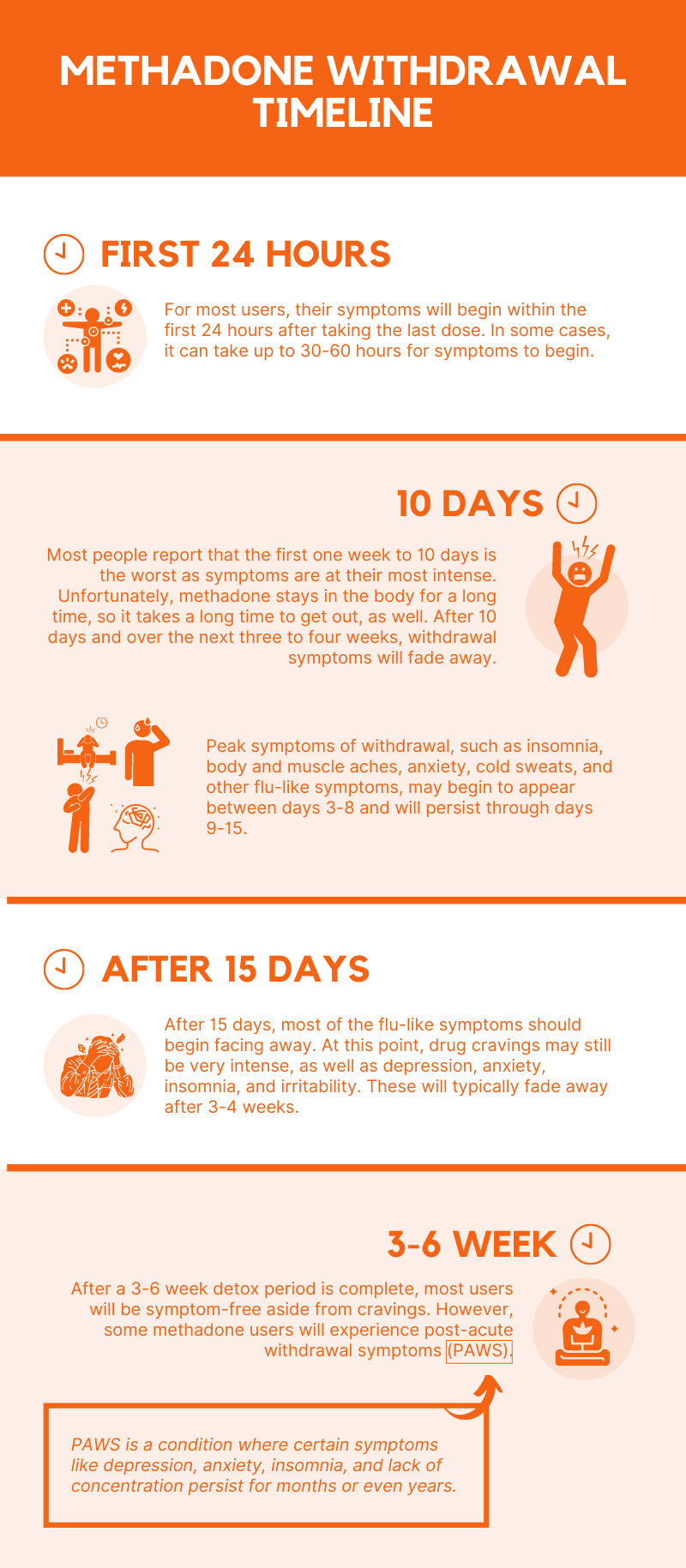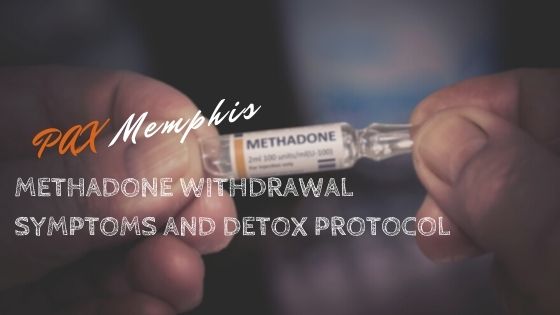Methadone is a medication that is often prescribed to treat symptoms of opioid withdrawal. However, the drug itself can be habit-forming. After long-term use, methadone withdrawal symptoms mimic those of opioid withdrawal and can last for several weeks. Medical detox programs are available to help treat withdrawal symptoms and ensure the patient’s safety.
Although effective when used correctly, methadone also has a high abuse potential. According to the 2016 National Survey on Drug Use and Health (NSDUH), 346,000 people aged 12 and older reported abusing the drug that year.[1] As an opioid drug, methadone can lead to physical and psychological dependency, which requires help from a professional detox and treatment program.
Understanding Methadone Withdrawal
Methadone is an opioid that was originally created by German doctors during World War II to treat extreme pain. Today, it may be used as pain relief treatment, however, it is most often prescribed to people who are trying to overcome an addiction to opioids like heroin or narcotic painkillers. The medication works by changing the way the nervous system and brain respond to pain so that users feel relief.[2]
People who take methadone for opioid addiction treatment may become physically dependent on the drug, even if they are taking it as prescribed by their doctor. On the other hand, some people abuse methadone to get high, and individuals who abuse the drug excessively will also develop a physical dependence. Physical dependence occurs when the body becomes reliant upon a substance for function normally. Someone who is physically dependent will experience methadone withdrawal symptoms if they quit taking the drug.
Withdrawal is a natural, yet uncomfortable process. It has to occur because the body must learn to regain balance and function without having methadone in the system. However, this process can last for weeks and symptoms can be extremely bothersome, making recovery challenging.
Methadone Withdrawal Symptoms
Drug withdrawal is different from one person to the next. The symptoms and duration of withdrawal depend on many factors, two of the biggest being:[3]
- How long a person has been using and dependent on methadone
- What dose a person’s body is used to taking
Symptoms of methadone withdrawal are similar to those from morphine or heroin withdrawal, however, it is thought to last far longer than regular opiate withdrawal. The flu-like symptoms users experience include:
- Chills or goosebumps
- Sweating
- Fever
- Depression, anxiety, and irritability
- Muscle and body aches and pains
- Nausea and vomiting
- Increased heart rate
- Stomach cramps
- Diarrhea
- Insomnia
- Drug cravings
- Paranoia
- Hallucinations
Users who have co-occurring disorders or are addicted to additional substances may experience more intense withdrawal symptoms that last for longer lengths of time.
Methadone Withdrawal Timeline

For most users, their symptoms will begin within the first 24 hours after taking the last dose. In some cases, it can take up to 30-60 hours for symptoms to begin. Most people report that the first one week to 10 days is the worst as symptoms are at their most intense. Unfortunately, methadone stays in the body for a long time, so it takes a long time to get out, as well. After 10 days and over the next three to four weeks, withdrawal symptoms will fade away.
Peak symptoms of withdrawal, such as insomnia, body and muscle aches, anxiety, cold sweats, and other flu-like symptoms, may begin to appear between days 3-8 and will persist through days 9-15. After 15 days, most of the flu-like symptoms should begin facing away. At this point, drug cravings may still be very intense, as well as depression, anxiety, insomnia, and irritability. These will typically fade away after 3-4 weeks.
After a 3-6 week detox period is complete, most users will be symptom-free aside from cravings. However, some methadone users will experience post-acute withdrawal symptoms (PAWS). PAWS is a condition where certain symptoms like depression, anxiety, insomnia, and lack of concentration persist for months or even years. Most of these symptoms can be treated with the help of a substance abuse treatment program.
Methadone Detox Protocols
Since methadone withdrawal can lead to uncomfortable and serious symptoms, those who are addicted should attend a medical detox facility when they are ready to get sober. The majority of addiction treatment programs offer methadone detox services to help reduce the severity and intensity of your symptoms.
Quitting methadone cold-turkey is never recommended. Doing so will only cause more intense and painful withdrawal symptoms. At-home detox or sudden withdrawal can also lead to life-threatening complications, such as severe dehydration or aspiration. Instead, doctors recommend that people taper off of the medication with decreasing doses. Tapering offers a smooth transition away from physical dependency.[4] Most importantly, users should always detox from methadone under the close supervision of a doctor or rehabilitation specialist.
When you arrive at detox, you will meet with a doctor to discuss your medical history and your substance use. They may also collect urine and blood samples to run certain labs that will help them determine your treatment plan. In most cases, methadone detox will involve a taper during which you will have a set schedule of reducing your daily dosage of the drug. This tapering schedule varies from one person to the next depending on their individual situation.
If you are still experiencing withdrawal symptoms while tapering off of methadone, your doctor may prescribe additional medications such as:
- Clonidine for high blood pressure, rapid heartbeat, and cramps
- Trazodone or other sleep aids to help with insomnia
- Pepto Bismol to help reduce diarrhea and cramping
- Over-the-counter pain relievers such as Tylenol or ibuprofen to help with headaches or body pain
Find Treatment for Methadone Addiction Today
Drug rehab centers that staff a team of medical experts who treat opiate addictions can help you develop an individualized treatment plan to care for your methadone withdrawal symptoms and help you stay sober. People with moderate to severe methadone addiction should attend an inpatient detox and rehab program where they have access to 24/7 care and support. Inpatient treatment centers usually offer detox, group and individual therapy, 12-step groups, medical care, and aftercare programs.
Outpatient rehab is an option for those with a less severe diagnosis or those who can’t take time away from work, school, or family to go to inpatient treatment. Outpatient programs will require you to come to the facility each day to receive your methadone dose as you taper off of the drug and participate in group counseling sessions.
If you or someone you know is struggling with methadone addiction, we’re here to help. With the aid of a medically supervised detox center and quality treatment, recovery is possible. Pick up the phone and call today to speak with a dedicated addiction treatment specialist.
References:
Medically Reviewed: September 25, 2019

All of the information on this page has been reviewed and verified by a certified addiction professional.










